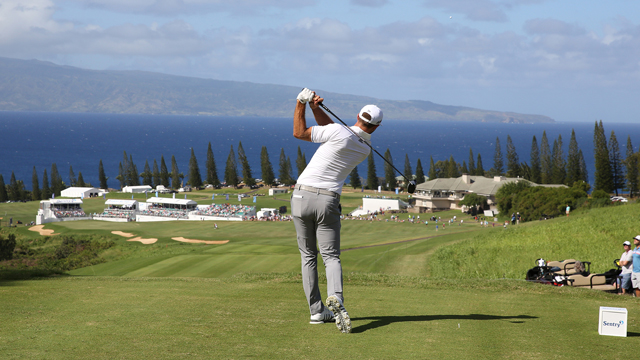NEWS
You might not be able to crush driver like Dustin Johnson, but you absolutely can get more distance off the tee. Here's how.

News flash: World No. 1 Dustin Johnson can absolutely crush a golf ball.
The latest evidence? How about Sunday on the 433-yard, par-4 12th hole at Kapalua's Plantation Course in the final round of the Sentry Tournament of Champions where DJ came within three inches of a hole-in-one?
Pretty good, right?
How did he do it?
"Pretty easy," 2013 PGA National Teacher of the Year Lou Guzzi said, "It's three words: He's Dustin Johnson. That's it. I was sitting with people who work at TaylorMade years ago and they talked about Dustin at their testing center. He can do things that no one else can. People need to keep that in mind and just enjoy watching him play."
There you have it. It's foolish for anyone to think they're going to go purchase a shiny, new driver and start nuking it like DJ.
But, it's very realistic to think there are actions you can take to hit better, more solid and longer drives.
Here are three tips from Guzzi on how you can get more distance -- and accuracy -- off the tee.
1. Get evaluated by a PGA Professional.
"Don't fool around with trying to find more speed in your swing on your own," Guzzi advised. "Let a PGA Professional evaluate your swing and make sure that what you're doing is correct and if you can challenge more speed."
2. Work on your flexibility and strength.
"Getting longer is all about flexibility and strength," Guzzi said. "The more flexible you are, the faster you can make your swing. Strength is important too. Get on a flexibility and strength program."
3. Put in the work on the range and get familiar with your numbers.
"You have to test it," Guzzi said. "Check the numbers on a launch monitor. In the case of my swing, I have a 'stock driver swing' and my 'extra 20 yards swing.' The stock swing for me is 108 mph and that's the swing that keeps it in the fairway under pressure. Once in a while, I'll go get the extra 20 on holes where I feel I can go at it a little more and get out of my comfort zone. If you go for more distaance, it's got to be on the right hole. The faster you swing, the more you challenge the fact you might lose accuracy. It's risk-reward and that's OK."
When you're looking for a drill to work on speed, Guzzi suggests hovering the driver off the ground and taking practice swings, while using your ears as a tool.
"Listen for the sound at the bottom of the swing," he said. "The lower the sound, the lower your swing speed. The higher the sound, the faster the swing speed. Let the ears be the guide and listen for that swoosh. You'll know where you're maxing out."
So much is made about how the majority of scoring is from inside 100 yards. That's true. And because of that, plenty of your practice time should be spent where it's going to show up most -- on your scorecard.
But do not abandon the driver, Guzzi said, make it a priority.
"Ben Hogan, from what I understand, felt driver was the most important club in the bag because if you weren't in the fairway, who cares about your skills?" Guzzi said. "To me, driver practice would be a priority. What are my priorities? I have to hit my driver well, hit it straight. I have to be a good driver to hit the fairways. I'll put in as much time as I have to to make that happen. The percentages might change. If I'm driving it well and can afford to spend less time on it, then I will. It's a priority though -- my first priority. I need that before I can take time on putting skills."
So long as you find a pattern with the driver and something you can keep in play -- maybe one day it's 3-5-yard fades and another day it's 10-15-yard fades -- there's no reason to miss fairways.
Adjust your alignment and as long as it's a pattern, you'll have a good driving day, Guzzi said.